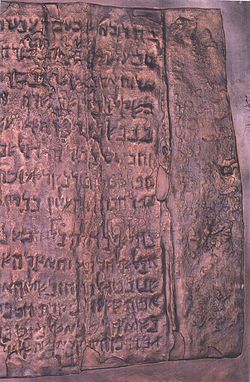
Back Rotlle de coure Catalan Kupferrolle von Qumran German Kupra rulaĵo Esperanto Rollo de Cobre Spanish Rouleau de cuivre French מגילת הנחושת HE Koperen rol van Qumran Dutch Miedziany Zwój Polish Manuscrito de cobre Portuguese Медный свиток Russian
The Copper Scroll (3Q15) is one of the Dead Sea Scrolls found in Cave 3 near Khirbet Qumran, but differs significantly from the others. Whereas the other scrolls are written on parchment or papyrus, this scroll is written on metal: copper mixed with about 1 percent tin, although no metallic copper remained in the strips; the action of the centuries had been to convert the metal into brittle oxide.[1] The so-called 'scrolls' of copper were, in reality, two separated sections of what was originally a single scroll about 2.4 metres (7.9 ft) in length. Unlike the others, it is not a literary work, but a list of 64 places where various items of gold and silver were buried or hidden. It differs from the other scrolls in its Hebrew (closer to the language of the Mishnah than to the literary Hebrew of the other scrolls, though 4QMMT shares some language characteristics), its orthography, palaeography (forms of letters) and date (c. 50–100 CE, possibly overlapping with the latest of the other Qumran manuscripts).[2]
Since 2013, the Copper Scroll has been on display at the newly opened Jordan Museum in Amman[3] after being moved from its previous home, the Jordan Archaeological Museum on Amman's Citadel Hill.
A new facsimile of the Copper Scroll by Facsimile Editions of London[4] was announced as being in production in 2014.[5]
- ^ J.T. Milik, The Copper Document from Cave III, Qumran, p. 61
- ^ "The Bible and Interpretation – On the Insignificance and the Abuse of the Copper Scroll". Bibleinterp.com. Retrieved 2015-11-26.
- ^ "Новости – Библейский альманах "Скрижали"". Luhot.ru. 2013-07-29. Retrieved 2015-11-26.
- ^ "Dead Sea Scrolls". Facsimile Editions. Retrieved 2015-11-26.
- ^ "Copied copper scroll is one to treasure". The Jewish Chronicle. 5 September 2014. Retrieved 15 June 2017.
© MMXXIII Rich X Search. We shall prevail. All rights reserved. Rich X Search

